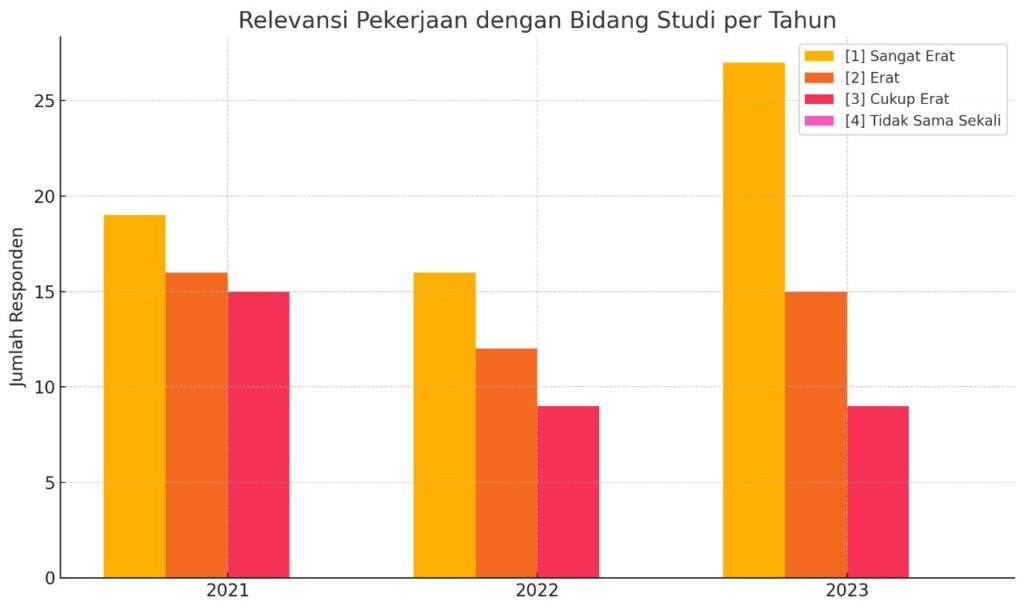
TRACER STUDY NARRATIVE REPORT: JOB RELEVANCE ANALYSIS OF GRADUATES OF FINE ARTS STUDY PROGRAM (2021-2023)
1. INTRODUCTION
This report is prepared based on the results of a tracer study of graduates of the Fine Arts Study Program, Faculty of Visual Arts and Design ISI Yogyakarta, for the period of graduation years 2021 to 2023. The main focus of this analysis is to see the extent to which the graduates' work is relevant to the field of study they took in college. In addition, this report also examines the fields of work pursued by graduates and their implications for curriculum development and strategies for improving the quality of art education.
2. METHODOLOGY
Data were obtained from tracer study forms filled out by graduates through an online platform. The analysis was conducted by focusing on two main aspects: (1) the category of job relevance to the field of study, and (2) the variety of work fields pursued by graduates. The data analyzed came from the following total respondents: 54 respondents (2021), 49 respondents (2022), and 58 respondents (2023).
3. KEY FINDINGS
3.1 Job Relevance Level
Job relevance is classified into four categories, namely: - [1] Strongly Relevant - [2] Strongly Relevant - [3] Moderately Relevant - [4] Not at All
The distribution of the data shows that: - In 2021, the majority of graduates considered their job to be "Very Close" (19 people) or "Close" (16 people) to their field of study - In 2022, a similar pattern was seen with the highest numbers in the "Very Close" (16) and "Close" (12) categories. - The year 2023 saw a sharp increase in the "Very Strong" category (27 people), indicating a positive trend in the connection between education and the world of work.
3.2 Variety of Work Fields
The most common fields of work include: - Fine artists and contemporary art practitioners - Independent designers - Art workers or artisans - Art teachers in formal/non-formal educational institutions - Self-employed in the creative sector
This shows that graduates not only occupy traditional positions as artists, but also diversify their professions in the broader context of the creative economy..
4. ANALYSIS AND INTERPRETATION
The high level of job relevance to the field of study is an indicator of the success of a curriculum that is responsive to the needs of the labor market and the professional art world. Within the framework of mediatization theory and art habitus, graduates demonstrate the ability to transform their academic skills into a dynamic, even cross-disciplinary work context.
However, there remained a number of respondents who felt that their work was only "Somewhat" or even "Not at all" related to their studies. This could be read as an indication of limited access to suitable employment or as a result of personal preferences that cut across sectors.
5. ACADEMIC IMPLICATIONS AND RECOMMENDATIONS
5.1. Strengthening Career Development: It is necessary to strengthen the career assistance system at the study program level, especially in providing orientation and wider job opportunities to students.
5.2. Adaptive Curriculum Development: The curriculum needs to be continuously updated to reflect the needs and developments in the arts and culture sector, including the integration of digital technologies and interdisciplinary practices.
5.3. Further Research: Further research is needed to explore the factors that influence graduates to work outside their field and how academic experience mediates their adaptation process.
6. CLOSING
This report illustrates that the majority of graduates of ISI Yogyakarta's Fine Arts Study Program successfully integrate their academic competencies into the world of work in a relevant manner. This finding is an important basis for the institution to formulate sustainable strategies to support students' transition from education to the professional world more effectively.